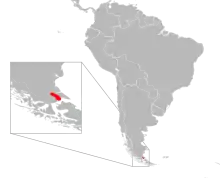Liolaemus sarmientoi
Liolaemus sarmientoi is a species of lizard in the family Liolaemidae.[3][2] It is considered a medium sized example of the species, with an average snout–vent length of 76 to 77mm,[4][5] with males usually larger than females.[5][6]
| Liolaemus sarmientoi | |
|---|---|
 | |
| Scientific classification | |
| Kingdom: | Animalia |
| Phylum: | Chordata |
| Class: | Reptilia |
| Order: | Squamata |
| Suborder: | Iguania |
| Family: | Liolaemidae |
| Genus: | Liolaemus |
| Species: | L. sarmientoi |
| Binomial name | |
| Liolaemus sarmientoi Donoso-Barros, 1973 | |
 | |
| Geographic range of L. sarmientoi | |
| Synonyms[2] | |
| |
Etymology
The lizard was first described by Chilean herpetologist Roberto Donoso-Barros in 1973. The species was initially categorized as a subspecies of Liolaemus archeforus, another Patagonian species described by Donoso-Barros and Cei in 1971, but was elevated to a distinct species after further study by Cei and Scolaro in 1996.[7]
The specific name sarmientoi comes from the Spanish explorer Pedro Sarmiento de Gamboa, known for his early transit through the Strait of Magellan, which runs near the habitat of the species' population.[8]
Geographic range and habitat
L. sarmientoi is considered one of the southernmost lizard species in the world,[5][9] being endemic to the southern region of Chile and Argentina known as Patagonia.[2][4][9] The species is saxicolous, living in rocky and volcanic areas.[5][4]
There is no estimate of the total population of the species on record.[4]
Behavior
L. sarmientoi, like most lizard species, is endothermic. Because of the harsh[5] climate conditions of the region in which L. sarmientoi lives, it is able to generate heat both by conductive means, i.e. via contact with warm surfaces, and heliothermic means, directly from the sun.[10] Their behavior is typically restricted by this climate, the species is most active during the spring and summer months, corresponding to between late November and February in the southern hemisphere, and lives in a state of dormancy, or brumation, from autumn through the start of the next spring.[5]
L. sarmientoi is omnivorous.[5]
Reproduction
L. sarmientoi is viviparous.[2] The reproductive cycle of the species is annual and takes place during the spring and summer, however, depending on climactic conditions, females of the species can adjust the reproductive cycle based on energy and food restrictions. Birth typically occurs in mid-summer, and litter sizes are typically between 3 to 5.[5]
References
- Abdala, S.; Avila, L.; Vidal, M.; Ortiz, J.C. & Nunez, H. "Liolaemus sarmientoi". IUCN Red List of Threatened Species. 2016: e.T56150793A56150806. doi:10.2305/IUCN.UK.2016-1.RLTS.T56150793A56150806.en.
- "Liolaemus sarmientoi". The Reptile Database. Retrieved 2021-01-27.
- "Taxonomy browser (Liolaemus sarmientoi)". www.ncbi.nlm.nih.gov. Retrieved 2021-01-27.
- Liolaemus sarmientoi (PDF). Ministerio del Medio Ambiente.
- Fernández, Jimena B.; Medina, Marlin; Kubisch, Erika L.; Manero, Amanda A.; Scolaro, J. Alejandro & Ibargüengoytía, Nora R. (April 2015). "Female reproductive biology of the lizards Liolaemus sarmientoi and L. magellanicus from the southern end of the world". Herpetological Journal. 25 (2): 101–108.
- Scolaro, José A.; Cei, José M. (April 30, 1981). "A New Northern Subspecies of Liolaemus kingi in Argentina". Journal of Herpetology. 15 (2): 210. doi:10.2307/1563382 – via JSTOR.
- Cei, Jose M. (23 October 1996). "A new species of Liolaemus of the archeforus group from the precordilleran valley of the Zeballos river, Santa Cruz Province, Argentina (Reptilia, Tropiduridae)" (PDF). Boll. Mus. reg. Sci. nat. Torino. Museo Regionale di Scienze Naturali di Torino. 14 (2): 389–401.
- Beolens, Bo; Watkins, Michael & Grayson, Michael (2011). The Eponym Dictionary of Reptiles. Baltimore: Johns Hopkins University Press. pp. xiii + 296 pp. ISBN 978-1-4214-0135-5.("Sarmiento", p. 233).
- Ibargüengoytía, Nora R.; Medina, S. Marlin; Fernández, Jimena B.; Gutiérrez, Joel A.; Tappari, Fabián & Scolaro, Alejandro (January 2010). "Thermal biology of the southernmost lizards in the world: Liolaemus sarmientoi and Liolaemus magellanicus from Patagonia, Argentina". Journal of Thermal Biology. 35 (1): 21–27. doi:10.1016/j.jtherbio.2009.10.003.
- Llanqui, Irbin B. (26 November 2020). "Aspects of the thermal ecology of Liolaemus theridgei Laurent, 1998 (Reptilia: Liolaemidae) from the Andes of Peru". Herpetology Notes. 13: 941–946.
